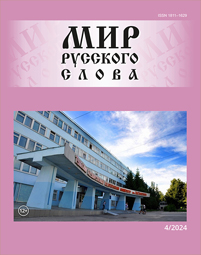Technologies for training Chinese philology students in listening to authentic news texts
DOI:
https://doi.org/10.21638/spbu30.2024.409Abstract
The article is devoted to the problem of developing listening skills among Chinese students at an advanced stage of training. The prerequisites for the introduction of new technologies into the educational process are described. Methodologists in China are actively searching for an effective model for teaching listening, since the Chinese state exam in Russian as a foreign language of the 8th level assumes that philology students should have developed the skill of understanding sounding authentic non-adapted media text by the end of the academic year. However, the few teaching aids on listening that are used in Chinese universities do not solve the problem, since they are aimed at monitoring already formed listening skills, and not at teaching listening. Based on many years of practical experience in Chinese universities, the author presents his vision of solving the problem and proposes an option for methodological support for an audiovisual course at an advanced stage of education. The basis of the proposed model is the prototypical nature of the news text and the repetition of communicative fragments in texts of the same thematic area. At the stage of learning listening, the author suggests using a question card consisting of universal questions as a visual support for understanding the general content of the news. The proposed model of teaching listening is aimed at developing a global and detailed understanding of the sounding news text and takes into account the characteristics of the Chinese system of linguistic education and the ethnopsychological characteristics of students. The article formulates the goals and objectives of the audiovisual course, briefly describes the “Listening” subtest, defines the thematic content of the course, describes the criteria for selecting language material, emphasizes the novelty of the proposed training model, describes the essence and role of the question card in the development of audit skills, gives the structure of the lesson, describes the stages working with news text, some types of tasks are presented.
Keywords:
Russian as a foreign language, Chinese students, hearing, news text, communication fragment, prototype text, question card
Downloads
References
Downloads
Published
How to Cite
Issue
Section
License
Articles of "The World of Russian Word" are open access distributed under the terms of the License Agreement with Saint Petersburg State University, which permits to the authors unrestricted distribution and self-archiving free of charge.




